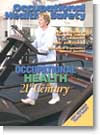
April 2004
Features
By Judith Barber
I smile whenever I see a program that integrates occupational health and employee assistance services. Having considerable exposure to both of these disciplines, I can see the sheer logic behind integrating them.
By Rick Wimberly
IN three years' time, the United States' perspective of public safety has dramatically shifted. Decades of relative stability within our country's borders have been usurped by the threat of violence, illness, and economic uncertainty.
By W. Gary Allread, Ph.D., AEP
THE emphasis on designing workplaces to accommodate individuals having a variety of physical differences has increased due to the knowledge and public awareness surrounding ergonomics. As both manufacturers and consumers understand, work environments that are more comfortable to use and adjustable to individual needs can reduce discomfort, the potential for fatigue, and cumulative trauma, as well as increase job productivity.
By Jonathan F. Bastian
THERMAL imagers (TIs) are sweeping through the North American fire service as more and more municipal fire departments adopt the technology. The Federal Emergency Management Agency recently reported approximately 25 percent of municipal fire departments have TIs.
By Bill Current
IN 2001, at an exotic animal ranch in Florida, a 550-pound crossbred Siberian tiger mauled to death a 49-year-old volunteer worker. According to the Associated Press, the worker was attempting to qualify for his own license to keep "big cats" when the tiger broke through a chain link, grabbed the worker by the neck, and pulled him to the ground. The official report of the incident said the man died in seconds of a broken neck.
By Jerry Laws
Editor's note: Ambassador Medical Services Inc. of Marlton, N.J., a third-party administrator of federally required testing programs, has seen its business shift from 100 percent DOT testing at startup in 1988 to a 40 percent DOT/60 percent non-DOT mix today.
By William H. Kincaid, P.E., CSP
A large construction company was building a multi-story office building in St. Louis. Partway through the job, a worker fell more than 30 feet through a hole in a partially decked floor. He died as a result of severe injuries a few hours later.
By Matthew A. Forck
I supervise electrical distribution line workers. We start each week with a safety meeting. Being the highly effective supervisor that I am, I have a folder of safety stuff I draw from when we don't have a video or speaker.
By Casey Hayes
LIFE just keeps getting more and more complicated. Between advancements in industrial technologies, increasing productivity pressures, and a general "need-for-speed," most safety professionals are constantly adjusting their thinking and processes.
By Steven M. Sayer
WHAT is your company's agenda when an employee cuts himself while handling a knife (or any other incident that induces bleeding)? What happens if an employee contracts Hepatitis B (HBV) or the HIV virus while rendering first aid or CPR to a critically injured employee?
By Fred Elliott
THE American public buys more than five billion over-the-counter drug products each year. A June 2003 national survey examining use of OTC medications indicated more of us are reading labels and checking out possible side effects, but we still have far to go, the National Council on Patient Information and Education noted last fall when it launched its latest consumer education campaign, "Be MedWise Prescription for Taking OTC Medicines."
By Bill Douglas
SLIPS and falls are one of the leading causes of workplace injuries in the country. In fact, the National Safety Council reports more than 300,000 injuries occur each year as a result of slips, trips, and falls in the workplace, averaging almost $7,000 per accident in lost compensation and medical costs.
Departments
By Jerry Laws
HERE'S a safety message with attitude: Most Americans are clueless about their own safety, American Red Cross President and CEO Marsha J. Evans says. (And who knows more about community preparedness than the Red Cross? When we're in trouble--burned out by fire, flattened by an earthquake or tornado--ARC responds, at a pace of about 70,000 disasters per year.)
By Valerie Weadock
THE most valued employee is often the most versatile. The more job tasks you can perform well, the more appreciated you are by your company. This notion also applies to computer programs.
By Joanne Sujansky, Ph.D.
BEFORE making assumptions about employee retention based on past experience, consider that you are about to see a new wave of employees with a whole new set of expectations swarm the workplace. Known as Generation Y, they might have a few traits that will surprise even the seasoned manager.